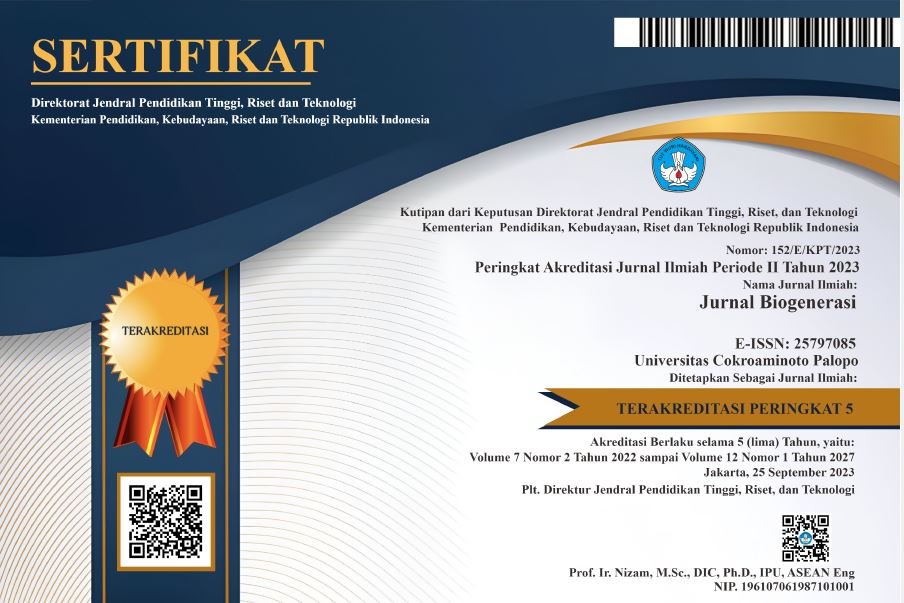PRODUKSI BIOLISTRIK OLEH KONSORSIUM BIKULTUR BAKTERI TERMOFILIK MENGGUNAKAN KONFIGURASI FERMENTOR RANGKAIAN SERI PADA MICROBIAL FUEL CELL
DOI:
https://doi.org/10.30605/biogenerasi.v10i2.5877Keywords:
Microbial Fuel Cell, Bioelectrical, Series Series, Consortium, Thermophilic BacteriaAbstract
The increasing global energy demand and the negative impact of the use of fossil energy on the environment encourage the use of environmentally friendly renewable energy sources, one of which is through Microbial Fuel Cell technology. This study aims to measure or analyze bioelectrical production by utilizing a consortium of thermophilic bacterial bicultures (SSA 14 and SSA 16) in an MFC system arranged in a series circuit configuration. The research method was carried out experimentally in the laboratory using a dual-chamber reactor arranged in a series of two and three series, with voltage measurements carried out every 2 hours for 24 hours. The results showed that the series three series produced a higher average voltage (0.823 V) than the series two series (0.744 V). This study indicates that the addition of the number of fermenter units in the series series significantly increases the electrical voltage produced.
Downloads
References
Ananto, I. R., Marzuki, I., Wicaksono, I., & Sunyoto, A. (2023). Optimasi Energi Listrik Berbasis Microbial Fuel Cell Berbahan Feses Sapi Menggunakan Rangkaian Seri. Jurnal JEETech, 4(1), 38–47. https://doi.org/10.32492/jeetech.v4i1.4106
Angural, S., Bala, I., Kumar, A., Kumar, D., Jassal, S., & Gupta, N. (2020). Bleach Enhancement of Mixed Wood Pulp by Mixture of Thermo-aAlkali-Stable Xylanase and Mannanase Derived Through Co-Culturing of Alkalophilic Bacillus sp. NG-27 and Bacillus nealsonii PN-11. Heliyon, 7(1).
Arbianti, R., Tania S. U., Heri H., Deni N., Ester K., & Ira T. (2013). Performance Optimization of Microbial Fuel Cell Using Lactobacillus bulgaricus, Makara Journal of Technology, 17 (1): 32-38
Fitriana, M. A’an A., Faisal A., Zidny M. (2023). Bioelectricity Of Cocoa Pod Waste As A Substrate In A Double Chamber Microbial Fuel Cell. Jurnal Media Elektro, 12(2)
Ibrahim, B., Suptijah, P., & Adjani, Z. N. (2017). Kinerja Microbil fuel Cell penghasil biolistrik dengan perbedaan jenis elektroda pada limbah cair industri perikanan. Jurnal Pengolahan Hasil Perikanan Indonesia, 20(2), 296-304
Ibrahim, B., Suptijah, P., & Rosmalawati, S. (2014). Kinerja Rangkaian Seri Sistem Microbial Fuel Cell sebagai Penghasil Biolistrik dari Limbah Cair Perikanan. Jurnal Pengolahan Hasil Perikanan Indonesia, 17(1), 71–79.
Irdawati, I., Hidayati, Z., Advinda, L., Fifendy, M., & Salvia, S. (2023). Specific Thermophilic Bacterial Xylanase Enzyme Activity Using Rice Straw as Substrate and Its Possibilityas an Eco-friendly Fabric Bleach. In 3rd International Conference on Biology, Science and Education (IcoBioSE 2021)(pp. 67-75). Atlantis Press.
Irdawati, Mades Fifendy, dan Nofri Yenti. (2015). Penapisan Bakteri Termofilik Penghasil Enzim Amilase dari Sumber Air Panas Sapan Sungai Aro 35 Kabupaten Solok Selatan. Jurnal Eksakta. 1: 74.
Irdawati, Putri, I.S., Syamsuardi, Agustien, A., Rilda, Y. 2018. The Thermophilic Bacterial Growth Curve. Bioscience. 2(2): 58-64.
Khaled, F., Vitoria, L., Alcaraz, M. L., & Miguel, M. (2015). Voltage balancing strategies for serial connection of microbial fuel cells. The European Physical Journal Applied Physics, 71(1), 10901.
Kim, B., Choi, S., & Yang, Y. (2012). Voltage increase of microbial fuel cells with multiple membrane electrode assemblies by in series connection. Electrochemistry Communications, 23, 52–55.
Logan, B. E., Hamelers, B., Rozendal, R., Schröder, U., Keller, J., Freguia, S., ... & Rabaey, K. (2006). Microbial fuel cells: methodology and technology. Environmental Science & Technology, 40(17), 5181-5192.
Manurung, S. R., & Sinambela, M. (2018). Perangkat Pembelajaran IPA Berbentuk LKS Berbasis Laboratorium. INPAFI (Inovasi Pembelajaran Fisika), 6(1).
Marhadi, & Ardisal. (2019). Meningkatkan Kemampuan Merangkai Listrik Sederhana Melalui Multi Metode Pada Anak Tunarungu di SLB Al-Ishlah Padang. Jurnal Penelitian Pendidikan Kebutuhan Khusus, 7(I), 222–227
Marshall, C. W & May, H. D. (2009). Electrochemical Evidence of Direct Electrode Reduction by a Thermophilic Gram-Positive Bacterium, Thermincola ferriacetica. Energy & Environmental Science, 2(6), 699-705.
Nawaz, A., ul Haq, I., Qaisar, K., Gunes, B., Raja, S. I., Mohyuddin, K., & Amin, H. (2022). Microbil fuel Cells: Insight into simultaneous wastewater treatment and bioelectricity generation. Process Safety and Environmental Protection, 161, 357-373.
Nisa, F. K., Daffa A. R., Yulialisa R. K., Yunisa A. N., Sahda A. N., Junia D. P., Yuni R. (2024). Analisis Pemahaman Konsep Rangkaian Listrik Seri dan Paralel melalui Praktikum Sederhana. Jurnal Belaindika:Pembelajaran dan Inovasi Pendidikan, 6(2): 107-118
Obileke, K., Onyeaka, H., Meyer, E. L., & Nwokolo, N. (2021). Microbial fuel cells, a renewable energy technology for bio-electricity generation: A minireview. Electrochemistry Communications, 125, 107003.
Pham, C. A., Jung, S. J., Phung, N. T., Lee, J., Chang, I. S., Kim, B. H., & Yi, H. (2006). A novel electrochemically active and Fe(III)-reducing bacterium phylogenetically related to Thermincola species isolated from a microbial fuel cell. FEMS Microbiology Letters, 223(1), 129-134.
Rabaey, K., & Verstraete, W. (2005). Microbial fuel cells: novel biotechnology for energy generation. Trends in Biotechnology, 23(6), 291-298.
Siswanti, A. C. (2016). Pengaruh Variasi Optical Density Bakteri Bacillus subtilis Terhadap Efisiensi Listrik Microbial Fuel Cell. Unesa Journal Of Chemistry, 5(3).
Sitorus, B. (2010). Diversivikasi Sumber Energi Terbarukan Melalui Penggunaan Air Buangan dalam Sel Elektrokimia Berbasis Mikroba. ELKHA 2. No. 1: 10-15.
Sulistiyawati, I., Rahayu, N. L., & Purwitaningrum, F. S. (2020). Produksi Biolistrik Menggunakan Microbial Fuel Cell (MFC) Lactobacillus bulgaricus dengan Substrat Limbah Tempe dan Tahu. Majalah Ilmiah Biologi BIOSFERA: A Scientific Journal, 37(2), 112-117.
Vestimarta, A. W., & Irdawati, I. (2024). Produksi Biolistrik dengan Microbial Fuel Cell (MFC) dari Bakteri Termofilik. MASALIQ, 4(1), 359–366. https://doi.org/10.58578/masaliq.v4i1.2632
Downloads
Published
How to Cite
Issue
Section
License
In submitting the manuscript to the journal, the authors certify that:
- They are authorized by their co-authors to enter into these arrangements.
- The work described has not been formally published before, except in the form of an abstract or as part of a published lecture, review, thesis, or overlay journal.
- That it is not under consideration for publication elsewhere,
- That its publication has been approved by all the author(s) and by the responsible authorities – tacitly or explicitly – of the institutes where the work has been carried out.
- They secure the right to reproduce any material that has already been published or copyrighted elsewhere.
- They agree to the following license and copyright agreement.
License and Copyright Agreement
Authors who publish with this journal agree to the following terms:
- Authors retain copyright and grant the journal right of first publication with the work simultaneously licensed under Creative Commons Attribution License (CC BY 4.0) that allows others to share the work with an acknowledgment of the work's authorship and initial publication in this journal.
- Authors are able to enter into separate, additional contractual arrangements for the non-exclusive distribution of the journal's published version of the work (e.g., post it to an institutional repository or publish it in a book), with an acknowledgment of its initial publication in this journal.
- Authors are permitted and encouraged to post their work online (e.g., in institutional repositories or on their website) prior to and during the submission process, as it can lead to productive exchanges, as well as earlier and greater citation of published work.


.png)

